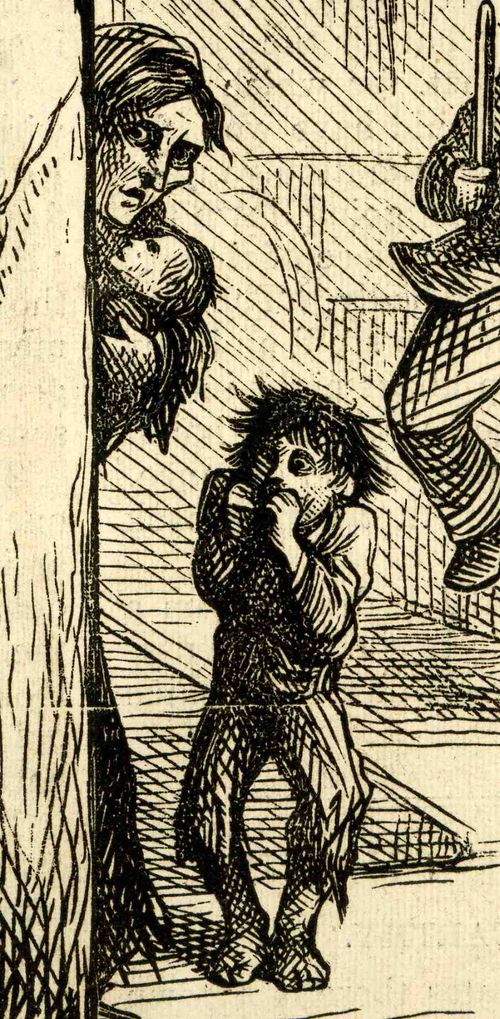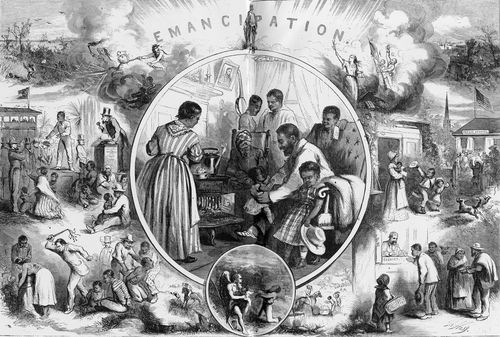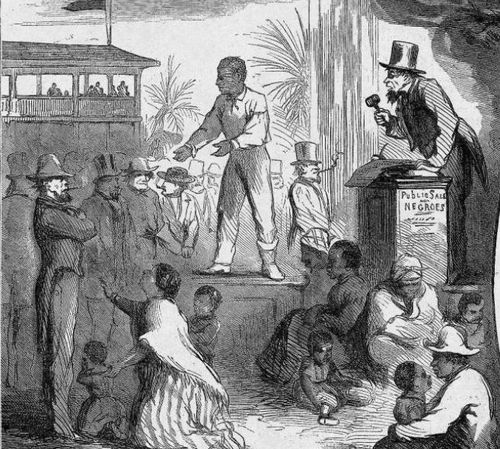JF Ptak Science Books Post 2267
Thomas Nast, the great social commentator and cartoonist for Harper's Weekly magazine through the course of the Civil War and into the 1880's, ddrew this fantastic allegorical image called "The Emancipation of the Negroes, January, 1863—The Past and the Future,"which was published just weeks after the Proclamation was issued in January 1863. Nast (1840-1902) was an extraordinary talent who created the politically/socially influential political cartoon. He worked tirelessly for Harper’s Weekly, joining the weekly illustrated newspaper in 1858 at the age of 19, contributing at least one large (usually front cover) political statement and two smaller cartoons every week, for 26 years. He wielded an enormous social influence, electing a president (Hayes) and toppling Boss Tweed. He was a staunch Republican who endlessly fought for balanced budgets, free education, and equal rights for Indians and Blacks, fair economic play to the working classes, and was viciously anti Klan. He also created the popular images of Santa Claus, Uncle Sam, the Republican elephant Democrat donkey, and the Tammany tiger.
The Emancipation image was perhaps one of his greatest early efforts--it is a strong image, holding nothing back. On either side of the main/central figure is the Good/Evil of the African American'experience, showing whipping, branding,the very dogs of war let loose on runaway slaves. In the middle-left we see a truly heartbreaking scene (enlarged below) depicting a "Public Sale/Negroes", with families being torn apart, broken in front of themselves, the husband/father pleading while the wife/mother with children beg for the atrocity to end. Nast was not afraid to use children in his images to makes his point, and it seems to me to be a rare practice. (This would continue throughout his career, especially in his depicting of the Hamburg S.C. massacre in which he shows a murdered Black baby--very tough stuff now but ever more so for 1876. He used children to make political points, showing them terrified and in fear of some monstrous public act,m and rightfully so, because children are always effected, and Nast was determined not to shield his viewers/readers from the baseline truth.)
Here's a very shocking example of this work, showing a terrified child reacting to his father being arrested for stealing bread for his starving family. It is from his work "Wholesale and Retial", a piece on Corporate Pig Thievery, and contrasts Tweed-like figures in the panel below stealing from a bank with teh approval of saluting cops. (I've written about this image here.)
[Image source: http://thomasnastcartoons.com/2012/06/02/irish-as-sub-human/the-emancipation-of-the-negrosnjan-24-1863/#main]
On the right side of the image are scenes of tranquility, with people lined up to receive pay for work done, and children dashing off to school.
The central image is significant, because it is simple and shows a scene of domesticity and happiness, and applies it to the African American. It establishes a new sense of "normalcy" or a common standard, at least in theory. To me it is a radical image. It shows a father in slippers bouncing one of his four children on his knee in front of a lighted stove, seated in a good chair. Grandma looks in on the scene, the mother looks on; a younger son pauses from reading to watch, while in the background the older son seems very interested in a courtship with a young lady. On the wall in the background is a portrait of Lincoln, with a banjo hanging up next to it.
Above the image is a somewhat squishy Columbia--the symbol of America--dividing the hellish scene left and grateful and hopeful scene to the right, with Justice and cheering soldiers just to Columbia's left hand. At the bottom of the central image we see Father Time holding the infant New Year, freeing a slave, the baby doing something on the first day of 1863 that the old man could not accomplish in the year(s) previous.
The image is complex and textured, a standard of Nast's work--and this one, unlike most of his efforts, is one of celebration and hope.





Comments